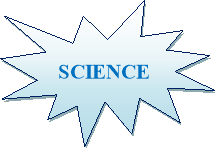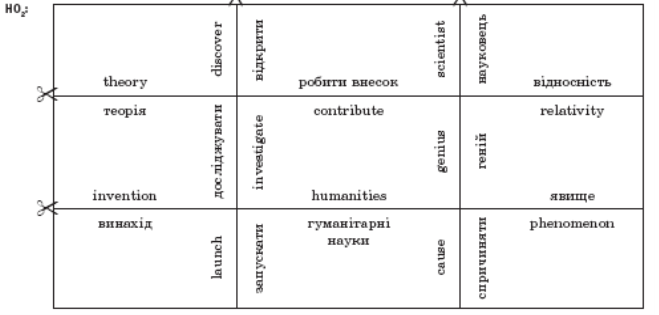Конспект уроку на тему: "Наука та технології. Наукові винаходи." 11 кл
Date: 26.03.2014 Unit 5. Science and Technology Form 11
Тема 5: Наука та Технологія
УРОК 1
Підтема: Наукові винаходи.
Мета: Ознайомити з новими ЛО.
Удосконалювати техніку читання.
Розвивати навички монологічного й діалогічного мовлення.
Продовжувати формувати вміння писемного мовлення.
Розширити уявлення учнів про наукові галузі.
Розвивати ерудицію учнів.
Виховувати пізнавальний інтерес.
Обладнання: Підручник, робочий зошит, картки для роботи в парах, для сам. роб.
ХІД УРОКУ
І. ПІДГОТОВКА ДО СПРИЙНЯТТЯ ІНШОМОВНОГО МОВЛЕНЯ
Greeting 1. Привітання.
T: Hello, children! I’m very glad to see you!
Ps: We are glad to see you too!
Aim 2. Повідомлення теми та мети уроку.
T: Today we’ll start a new topic — «Science and Technology», and at this lesson we are going to focus on certain areas of science and academic disciplines. We’ll practice the use of the Passive Voice forms.
Motto: Science and technology have changed people’s lives for better.
Warming up 3. Уведення в іншомовну атмосферу.
Метод «Мозкового штурму».
Учитель зображує схему на дошці, а учні підказують йому слова.
 T: What words do you associate with the topic «Science»?
T: What words do you associate with the topic «Science»?
Бесіда з учнями.
T: What scientists/inventors do you know?
What are they famous for?
What areas of study did they work in?
What countries were they from?
ІІ. ОСНОВНА ЧАСТИНА УРОКУ
Presenting and Practising Vocabulary 1. Подання й активізація лексичного матеріалу.
Гра «Magic Square».
Учні працюють в парах. Кожній парі видається квадрат, розрізаний на дев’ять маленьких квадратиків. На кожній стороні квадратів записані слова — англійською та українською мовами. Пари повинні якомога скоріше зібрати великий квадрат, поєднуючи маленькі квадратики так, щоб суміжні сторони мали одне й те саме слово англійською та українською. Виграє пара, що збере квадрат першою. Учитель стежить за правильністю виконання завдання.
T: Make up a square.

Reading 1. Подання тексту для читання.
1) Pre-Reading Activity. Етап підготовки до читання.
Робота з картками.
Учні отримують картки і виконують завдання в парах. По закінченні роботи вони ланцюжком читають речення. Учитель контролює правильність відповідей.
HO1: Do you know these technological terms? Read the sentences and circle the correct variant of the word.
1) Motherboard/GoogleTM is the most popular search engine on the Internet.
2) A DVD/Floppy Disc is an optical storage medium which has greater capacity and bandwidth than a CD.
3) The Operating system/Internet is the worldwide information highway comprised of thousands of interconnected computer networks, and reaches millions of people in countries around the globe.
4) Virus/Java is a program that infects a computer by attaching itself to another program which then spreads when that program is run.
5) ROM/RAM is the memory that can be read but not changed.
6) Downloading/Surfing is the process of transferring data or programs from a server or host computer to one’s own computer or device.
7) Java/Vlog is a general-purpose programming language developed by Sun® Microsystems.
8) Memory/ROM is the working space used by the computer to hold the program that is currently running, along with the data it needs, and to run programs and process data.
9) Program/Network is a group of interconnected computers, including the hardware and software used to connect them.
10) Downloading/Surfing means looking at a variety of things casually, especially while browsing the Internet or television channels.
11) File transfer/Uploading is the process of transferring data files or programs from a computer or device to a server — usually on the World Wide Web.
12) Vlog/DVD is an online video blog.
2) Reading. Етап читання.
Учні самостійно читають текст і доповнюють речення.
Read the text and continue the sentences below.
SCIENCES
Scientific fields are commonly divided into two major groups: 1.natural sciences, which study natural phenomena (including biological life), and 2.social sciences, which study human behaviour and societies. These sciences are called empirical, which means the knowledge must be based on 3.observable phenomena and capable of being tested for its validity by other researchers working under the same conditions.
4.The humanities are academic disciplines which study the human condition, using methods that are primarily analytic or critical. 5.Examples of the disciplines of the humanities are ancient and modern languages, literature, history and philosophy.
6.Formal sciences, like mathematics, statistics and logic, are important to the empirical sciences. 7.The formal sciences are essential in the formation of hypotheses, theories, and laws, both in discovering and describing how things work (natural sciences) and how people think and act (social sciences).
8. Mathematics, which is classified as a formal science, has both similarities to and differences from the natural and social sciences. 9. It is similar to empirical sciences in that it involves an objective, careful and systematic study of an area of knowledge; it is different because of its method of verifying its knowledge, using a priori rather
than empirical methods.
- Natural sciences study…
- Social sciences study…
- In empirical sciences the knowledge must be based on…
- The humanities are…
- Examples of the disciplines of the humanities are…
- The examples of formal sciences are…
- The formal sciences are essential in…
- Mathematics has both similarities to and differences from…
- Mathematics is similar to empirical sciences in that…
3) Post-Reading Activity. Етап перевірки розуміння змісту тексту.
Учні ланцюжком читають відповіді. Учитель контролює їх правильність.
Grammar Revision and Practice 2. Повторення й відпрацювання граматичного матеріалу: пасивний стан дієслів.
1) Бесіда з учнями.
T: Let’s remember why we should use the Passive Voice forms.
Учні разом з учителем пригадують випадки використання дієслівних форм пасивного стану; учитель ілюструє кожний випадок прикладом, а потім учні наводять власні приклади.
T: How do we form the Passive Voice? (пише на дошці)
to be (finite form) + Past Participle
e.g. A letter was written.
Now give your own examples.
Writing 4. Розвиток навичок писемного мовлення.
p.251-252 Basic Level a
Учні письмово складають речення з дієсловами пасивного стану минулого часу.
Look at the pictures and make up sentences using the Past Passive when they were invented or discovered.
ІІІ. ЗАКЛЮЧНА ЧАСТИНА УРОКУ
Homework 1. Домашнє завдання.
c. 254 Впр. At Home
Summarizing 2. Підведення підсумків уроку.
Бесіда в режимі T→P1→P2→P3.
T: What topic have we discussed at the lesson today?
What new words have you learned?
What sciences can you name?
Додаткове завдання
Do the Invention Quiz and check your answers.
1) The invention of the refrigerator made a significant improvement to our standard of living. When it was invented, not many people wanted one.
Question. Who invented the refrigerator?
a) Oliver Evans.
b) Michael Faraday.
c) Carl Von Linde.
2) Many inventors contributed to the technology that created the television. There were conflicts between inventors over their rights to various aspects of this technology.
Question. Which of these inventors invented the television?
a) John Baird.
b) Philo Farnsworth.
c) Vladimir Zworykin.
3) This inventor was considered to be far ahead of his time. He recorded his inventions in journals. Many of these inventions did not become known until centuries later.
Question. Who was this inventor?
a) Galileo Galilei.
b) Leonardo da Vinci.
c) Nostradamus.
4) The inventors of ear muffs, the trampoline, braille, and the paper bag all have something in common.
Question. What do they have in common?
a) They are blind.
b) They are teenagers.
c) They are women.
5) Konrad Zuse and John Atanasoff were inventors that contributed to the development of an invention.
Question. What did they invent?
a) The computer.
b) The electron microscope.
c) The jet engine.
6) Question. Which inventor worked at a patent office?
а) Nikola Tesla.
b) Thomas Edison.
c) Albert Einstein.
7) This product was invented by a scientist working for this company.
Question. Which answer is correct?
a) Krazy Glue was invented at Kodak.
b) Velcro was invented at 3M.
c) Bungee Cord was invented at Ford.
8) This inventor was educated by his mother.
Question. Who was he?
a) Benjamin Franklin.
b) Alexander Graham Bell.
c) Thomas Edison.
The Answers: 1а; 2а; 3b; 4b; 5a; 6c; 7a; 8c
1


про публікацію авторської розробки
Додати розробку
